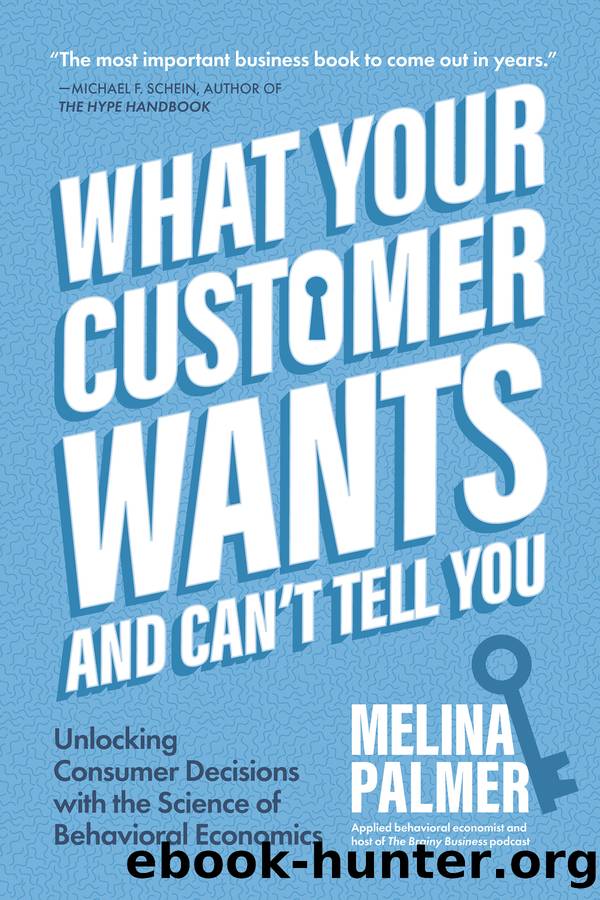What Your Customer Wants and Can't Tell You by Melina Palmer

Author:Melina Palmer
Language: eng
Format: epub
Publisher: Mango Media
Published: 2021-04-04T16:00:00+00:00
Chapter 16
Pain of Paying
Eighteen years before Kim Kardashian âbroke the internet,â AOL beat her to the punch by launching their new pricing model in 1996.127 Before that, you bought set blocks of internet time:
â¢Twenty hours a month for $19.95
â¢Five hours a month for $9.95
Most people chose the twenty-hour model and were using between ten and fifteen hours a month. Iâm sure someone at AOL said something like, âYou know, âunlimitedâ sounds so great. We could put that in our ads and reduce our tracking needs. It could be a win-win!â They probably assumed most people would still stay under twenty hours so it wouldnât be that big of a deal.
After all, someone using ten hours still had plenty of room before hitting their twenty-hour limit, so they must only have ten to fifteen hoursâ worth of stuff to do, right?
Totally logical. And totally wrong.
Usage quadrupled basically overnight, and AOL couldnât keep up. There were service issues and all sorts of problemsâthe company was even sued by a few users who struggled to use the system.
What happened? Why did everyone go bonkers once their internet access became unlimited?
Apparently, there was a little meter running in the corner whenever you logged on. You may remember it if you were using AOL about twenty-five years ago, but it was constantly tick-tick-ticking and counting the amount of time you were spending online. This kept the time you were spending in front of your conscious brain (time pressure), constantly reminding you there was a point soon where you might go over your limit.
No time limit = no clock.
And we all know how easy it is to get sucked into internet rabbit holes and not realize how long you have been jumping from site to site. Without a giant clock to remind you of the pain you will feel if you go over your limit, you are free to surf as much as you want. AOL learned that lesson the hard way.
This is also why Uber is so much easier to use than traditional taxis, where you are watching the meter tick up while sitting in traffic. Think about how your buying/user experience would differ if:
â¢Gyms charged for minutes in the facility or number of steps taken.
â¢Restaurants charged you per bite instead of for the meal.
â¢Netflix had a clock running and charged you for each fifteen-minute increment or show watched.
Constantly reminding your customers of payments and price is generally a bad business model. There is a very real pain of paying experienceâstudies show the insula (a pain center in the brain) lights up when making a payment.128 For us humans, this emotional pain is like physical pain. Luckily, just as Uber and AOL have discovered, there are ways to help people feel less pain when paying for things.
Interestingly, when the payment being made is time and not money (for instance, a long wait time), the reverse is true. Telling people about the process and what is going on behind the scenes can make wait times more tolerable.
Download
This site does not store any files on its server. We only index and link to content provided by other sites. Please contact the content providers to delete copyright contents if any and email us, we'll remove relevant links or contents immediately.
Zero to IPO: Over $1 Trillion of Actionable Advice from the World's Most Successful Entrepreneurs by Frederic Kerrest(4293)
Machine Learning at Scale with H2O by Gregory Keys | David Whiting(4179)
Never by Ken Follett(3790)
Harry Potter and the Goblet Of Fire by J.K. Rowling(3774)
Ogilvy on Advertising by David Ogilvy(3510)
Shadow of Night by Deborah Harkness(3302)
The Man Who Died Twice by Richard Osman(2997)
Book of Life by Deborah Harkness(2867)
The Tipping Point by Malcolm Gladwell(2827)
Will by Will Smith(2792)
0041152001443424520 .pdf by Unknown(2784)
My Brilliant Friend by Elena Ferrante(2774)
How Proust Can Change Your Life by Alain De Botton(2742)
Purple Hibiscus by Chimamanda Ngozi Adichie(2652)
How to Pay Zero Taxes, 2018 by Jeff A. Schnepper(2602)
Hooked: A Dark, Contemporary Romance (Never After Series) by Emily McIntire(2500)
Rationality by Steven Pinker(2291)
Borders by unknow(2227)
Can't Hurt Me: Master Your Mind and Defy the Odds - Clean Edition by David Goggins(2226)
